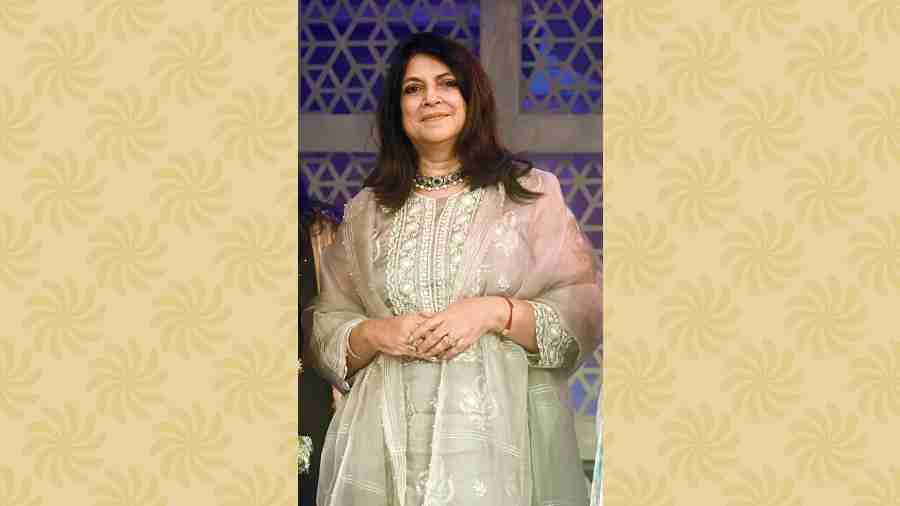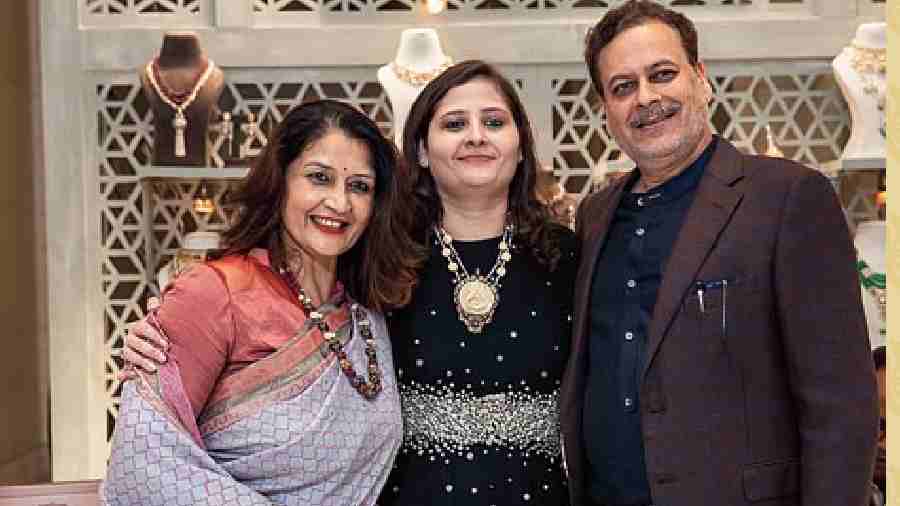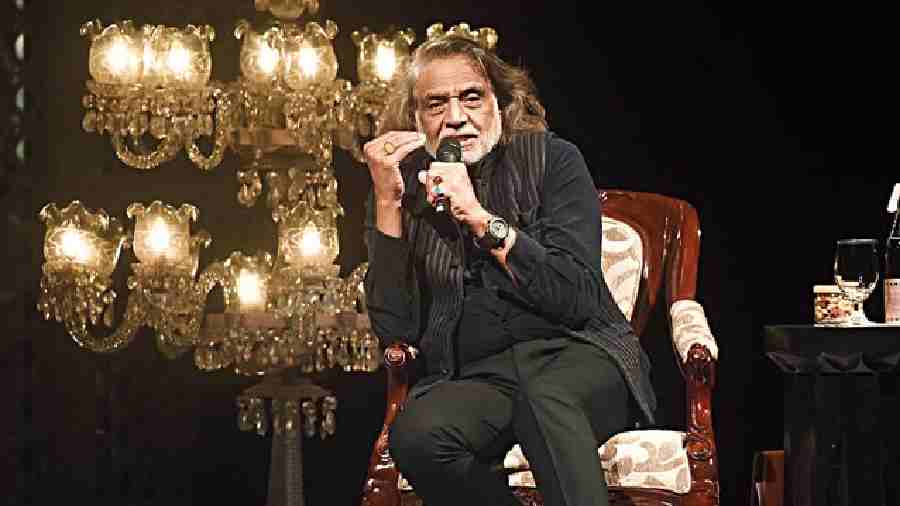“Weaver of Dreams”: The passion of Muzaffar Ali is a unique storytelling project that strings together film clips screening, music, dance, poetry, fashion and narration of anecdotes to share with people nuggets of master film-maker Muzaffar Ali’s life and works. The mixed-media production that has been presented in various Indian cities in the past few years, was brought to Kolkata on August 31 by the Ladies Study Group in the grand Stateroom of ITC Royal Bengal.
The spectacular set-up on stage depicting Mughal architectural designs was lit up with huge chandeliers, with Muzaffar sitting on one side of the stage in conversation with Sathya Saran, sitting on the other end. The conversation between the two began with the discussion on the impact of birthplace on an artiste’s growing mind. The stories surrounding revolution and India’s Partition, its effect on the people and land of Lucknow, the Awadhi culture of Lucknow and Kotwara, the colours and sounds of Muharram and a young Muzaffar witnessing his mother’s passion for art and craft were some of the things that had shaped his growing mind. The conversation, mood and ambience made a seamless transition into his first film Gaman.
Gaman
“If I hadn’t made Gaman, I would have made nothing,” said Muzaffar. The film based on migrant workers and the pain of separation found contemporary relevance during the Covid pandemic, too. “It tells the story of people being uprooted from their own land and being introduced to a new culture and its people. For me, it was coming to Kolkata for the first time. Everyone gave me so much respect here. The filmmakers here, the culture and the art opened up my mind. I went to Mumbai to work in corporate. But the essence I took back from Kolkata, the essence I felt every time I went back to Lucknow... Gaman was the poem of the dispossessed. I could only create visuals for that kind of poetry,” he added.
Umrao Jaan
“The eyes can tell an entire story. When I read Umrao Jaan, the eyes of the child and later the grown up woman told the entire story. I felt I was visualising the entire story, not reading it. And to see that, we need a very soft and distracted heart. I began to empathize with her vulnerability… for me person and place are vital to cinema,” said Muzaffar. He also shared how he found his heroine for the film, Rekha, by looking at her eyes on a magazine photo and knowing she was the one. “I saw her eyes in that picture. It conveyed to me that this is someone who can rise and fall in life and walk again,” he added.
Anjuman
It was the film that saw Shabana Azmi sing on screen and brought the mother-daughter duo, Shabana and Shaukat Kaifi together on screen. “This film has a lot of these nuances of metaphors, similes and imagery of what a human being can bring to the screen. Shabana gave the character an entertaining touch with that. Poetry was there… and it was this coming together of the craftswomen. People break their unity to reduce their wages. If I hadn’t made Gaman, I would not have made Anjuman. Art evolves through human pain. My anguish came from my city Lucknow. Until and unless you belong to some place you don’t feel the pain. Every film kept making me a sympathising human,” said Muzaffar
Clips of films showcasing the journey of House of Kotwara and Muzaffar’s work with various crafts of India followed. Dance performances and the fashion show were presented as interludes between the narratives of his films.
Jaanisaar
The film talked of the colonization of Awadh after the British took over and the changes that were brought in thus. “The fire of the revolution of 1857 had not died. People were living with that fire and I wanted to celebrate that fire. Independence is just a fluttering of the heart. Jaanisaar is a simple flutter of the heart which is based on knowing that you are captive when you are apparently free. This was the first time I composed music in a film,” said Muzaffar.

Madhu Neotia felicitated Muzaffar and Meera Ali on stage at the end of the show

The fashion show was woven into the storytelling and presented in three sequences by Meera Ali and daughter Sama, creative director of Kotwara. The first sequence was an ode to Indian textile and showcased the traditional zardozi work, the second sequence showcased the delicate Lucknowi craft of chikankari enhanced with zardozi and aari. The third sequence presented more colourful and modern silhouettes crafted with a timeless touch to it. The outfits were adorned with jewellery from Bhuramal Rajmal Surana Johuree.


“The first collection is from Umrao Jaan and the second and third collection is from our new collection and it is in the process of being launched. It is an ode to bridal couture but the way I see it. It is about letting a woman shine through the garments rather than be lost in them. It is based on a lot of experiences I have had while dealing with brides as my clients and my influences over the years. The floral designs are inspired from my childhood memories and travel. The rose gardens of Kotwara, our home garden in Delhi and those London parks, where I went to study. My Lucknow Awadhi heritage and my experience of studying in England and travelling through Europe have a lot of influences in this collection,” said Sama (left in picture).

Dance performances based on songs from Muzaffar Ali’s films were presented as interludes to the storytelling presented in the form of a conversation. Muzaffar Ali’s account of his works put the dance performances and the fashion show in context.

“I am a member of FDCI (Fashion Design Council of India) and I have always worked with crafts. Now, having given up work, I took up the LSG presidentship. But craft has always been at the back of my mind and in my growing years I have been going to Lucknow and loved the chikan craft from there. Then came the opportunity of meeting them and working this out and it was an amalgamation of different crafts, too. Kotwara from Lucknow and the jeweller by Bhuramal from Jaipur. It was tough to execute it but people really loved it,” said Sucheta Mehr, president of Ladies Study Group.


“Chandra Surana created the fusion of heritage and inspiring jewellery design. It was the vision of this seventh generation jeweller, who moved to Kolkata and Bengaluru to start Bhuramal Rajmal Surana (Johuree) while keeping the heritage location to establish the relation among the tradition and craftsmanship in the canvas of modernity. Our jewellery reflects the echoes of the royal past; the very past that composed Jaipur’s distinct culture. We are evolving every day with fresh and contemporary ideas and our idea behind our jewellery creation complemented very well the presentation by the House of Kotwara,” said Urvashi Surana Shaw (centre) with father Chandra Surana and mother Poonam Surana. (Above left) The display of their collection at LSG’s event.
Pictures: Pabitra Das
